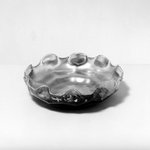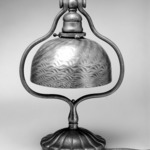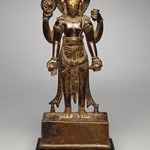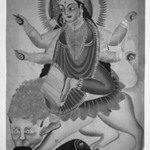
Narasimha Avatara
Asian Art
MEDIUM
Watercolor, ink and silver on paper
DATES
ca. 1910
DIMENSIONS
17 1/4 x 11 in. (43.8 x 27.9 cm) (show scale)



COLLECTIONS
Asian Art
ACCESSION NUMBER
1997.145
CREDIT LINE
Gift of Dr. Bertram H. Schaffner
CATALOGUE DESCRIPTION
Narasimha (Nara-man and Simha-lion), the incarnation of Vishnu, the Protector, was a popular character from Indian mythology. Narasimha is nearly always shown with a raised mane of a male lion and the stripes of a tiger. In this painting from Kalighat, a temple (ghat) site in Calcutta, eastern India, dedicated to the worship of the goddess Kali, Narasimha is shown as a composite mythical beast, rather than a lion. His tongue is shown hanging out like a makara (a mythical beast from Hindu mythology). His body is painted deep blue to indicate his associations with Vishnu, the Dark One. He is four-armed and lion-headed, with a groomed mane. His ears and tongue are painted bright red and orange. The image is well composed onto a stage-like setting. His semi-seated legs bent is a pose popular in Indian dance. Two of his hands are joined together on the demon's hand to depict the disembowelment of the demon. The other two are raised above his head to form a pose from Indian dance. Narasimha's lower garment (dhoti) is brightly painted in yellow and red, fanned skirt in the middle. The costume and the stage-like setting are influenced by local folk the dance performances. (Jyotindra Jain, lecture for Asian Art Council, April 1997)
The demon Hiranyakashaipu is painted green and he is holding a shield and a sword in each hand. The sword is painted in a single silver line. His lower torso is clothed in a blue dhoti and he is wearing western style shoes. His eyes are wide, although his expression is calm and stylized. He has a long mustache, which was fashionable among the nobility in this period. His hair hangs down in a long black mane. Although Narasimha's hands are only joined together across his mid-torso the blood demon's disemboweled torso is depicted in bright red and orange.
In the Narasimha legend, the demon Hiranyakashaipu had a boon from Brahma (the creator) that not be killed by any human being, or animal, or god; that he could not be killed during the day or that he could not be killed either on the earth or in the sky; that he could not be killed by a weapon; and could not be killed either outside a house or inside one. With such a boon, he began to consider him immortal, and to oppress and ill-treat pious and religious people. He tortured his son Prahlad because he persisted in worshipping Vishnu. To save his devotee, Prahlad, Vishnu incarnated himself as a man with a face and head of a lion and the body of a man. He annihilated Hiranyakashipu at dusk over the threshold of his house by tearing open his stomach with his claws, thus avoiding the terms of Brahma boon. (Amy G. Poster, notes from a lecture at the Hood Museum of Art for Realms of Heroism).
A striking quality of Kalighat painting is the use of long continuous lines as is seen in the eyes, jewelry and outlines of the clothing. There is a boldness and vigor in the brushstroke. The figures shaded to highlight the contours of the forms but images are not well modeled and appear rather colors of red, yellow and blue are bright and vibrant.
The satirical style, typical of the Kalighat School is evident in the use of a classic theme from Hindu mythology to make a seemingly political statement. (See Archer, 1971). The painting touch issues of the growing westernization of Calcutta society, a concern during this period. The western style of the demon's feet may also reflect the animosity toward the British, by equating them with the demon (Archer, 1971).
Condition: The colors are in very good conditions and extremely vibrant. There is a stain about an inch from the wedges, which indicates that it may be framed. There is a slight flaking of paper in the corners. There is some bleaching of the red pigment on the back.
MUSEUM LOCATION
This item is not on view
CAPTION
Narasimha Avatara, ca. 1910. Watercolor, ink and silver on paper, 17 1/4 x 11 in. (43.8 x 27.9 cm). Brooklyn Museum, Gift of Dr. Bertram H. Schaffner, 1997.145 (Photo: Brooklyn Museum, 1997.145_IMLS_SL2.jpg)
IMAGE
overall, 1997.145_IMLS_SL2.jpg. Brooklyn Museum photograph
"CUR" at the beginning of an image file name means that the image was created by a curatorial staff member. These study images may be digital point-and-shoot photographs, when we don\'t yet have high-quality studio photography, or they may be scans of older negatives, slides, or photographic prints, providing historical documentation of the object.
RIGHTS STATEMENT
No known copyright restrictions
This work may be in the public domain in the United States. Works created by United States and non-United States nationals published prior to 1923 are in the public domain, subject to the terms of any applicable treaty or agreement.
You may download and use Brooklyn Museum images of this work. Please include caption information from this page and credit the Brooklyn Museum. If you need a high resolution file, please fill out our online application form (charges apply).
The Museum does not warrant that the use of this work will not infringe on the rights of third parties, such as artists or artists' heirs holding the rights to the work. It is your responsibility to determine and satisfy copyright or other use restrictions before copying, transmitting, or making other use of protected items beyond that allowed by "fair use," as such term is understood under the United States Copyright Act.
The Brooklyn Museum makes no representations or warranties with respect to the application or terms of any international agreement governing copyright protection in the United States for works created by foreign nationals.
For further information about copyright, we recommend resources at the United States Library of Congress, Cornell University, Copyright and Cultural Institutions: Guidelines for U.S. Libraries, Archives, and Museums, and Copyright Watch.
For more information about the Museum's rights project, including how rights types are assigned, please see our blog posts on copyright.
If you have any information regarding this work and rights to it, please contact copyright@brooklynmuseum.org.
RECORD COMPLETENESS
Not every record you will find here is complete. More information is available for some works than for others, and some entries have been updated more recently. Records are frequently reviewed and revised, and we welcome any additional information you might have.





























